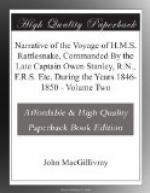We resumed our homeward voyage on July 25th, and thirty-six days afterwards crossed the equator in 24 degrees west longitude. The last pintado left us 240 miles within the tropics to follow an outward-bound vessel. Another petrel much resembling it—a new species with longer wings and different markings, the head, neck, and upper surface being dark chocolate, and the lower parts white—was abundant between the latitude of 46 and 40 degrees South, and between the parallels of 36 and 35 degrees South, Procellaria conspicillata was numerous, but unfortunately I had no opportunity of procuring specimens of either.
Five days after leaving the Falkland Islands, we encountered a very heavy gale, commencing at south-east, and blowing hardest at east, when the barometer was down to 29.264—next day the wind went round to the south-west and moderated. From the latitude of the entrance of the River Plate up to latitude 15 degrees South, we experienced northerly winds between East-North-East and West-North-West, after which we got winds commencing at South-West and merging into the South-East trade, which we may be said to have fairly got in 13 1/2 degrees South latitude and 23 1/2 degrees West longitude, and lost in 6 degrees North latitude, and 22 degrees West longitude. We picked up the North-East trade in latitude 13 degrees North and longitude 24 degrees West and carried it up to latitude 29 degrees North and longitude 37 1/2 degrees West. I mention these particulars as the limits of the trade-winds as experienced by us were considered to differ considerably from what was to be expected at this season of the year. Gulf weed made its first appearance in latitude 24 degrees North and longitude 35 1/2 degrees West but in small quantity, and was last seen in latitude 38 degrees North and longitude 33 1/2 degrees West in detached pieces, mostly dead. About 31 1/2 degrees North and 37 3/4 degrees West it was very plentiful, occurring in long lines from one to fifty yards in width, extending in the direction of the wind. Some pieces which were hooked up furnished on being shaken numbers of a minute univalve shell (Litiopa) many small fish—especially pipe-fish (Syngnathus) and numerous crustacea (of which Planes minuta was the most plentiful) while several delicate zoophytes were encrusted or attached to the weed. In short each little patch of gulf weed seemed a world in itself, affording the shelter of a home to hundreds of minute and wonderful animals.*
(Footnote. The gulf weed is still regarded as of questionable origin. Has it—unlike all other seaweeds—always existed as a floating plant, or has it been detached by storms from the bottom of the sea and carried by the currents of the ocean into the well defined region it now occupies and out of which it is never met with in any great quantity? Without entering into proofs, the principal of which are its not yet having been found attached to the shore, and the invariable absence of fructification—it seems probable that those botanists are in the right who consider the gulf weed (Sargassum bacciferum) to be merely an abnormal condition, propagating itself by shoots, of S. vulgare, which in its normal state grows upon the shores of the Atlantic and its islands. See note by Dr. J.D. Hooker in Memoirs of Geological Survey of Great Britain volume 1 page 349.)




